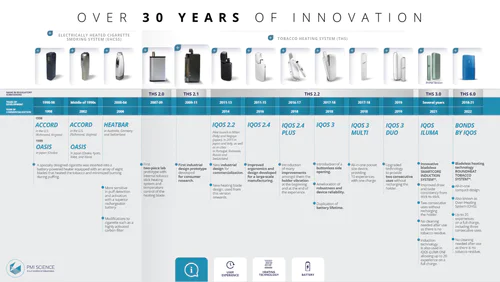The science behind THS
PMI has scientifically demonstrated that during the operation of THS—independent of which product version is considered—no combustion occurs, and the aerosol generated emits on average 95% lower levels of harmful and potentially harmful constituents (HPHCs), compared with cigarettes. However, this does not necessarily equal a 95% reduction in risk. The THS is not risk free and contains nicotine, which is addictive. But for adult smokers who don’t quit, it is a better alternative than continued smoking.
A number of public health organizations, including the U.S. Food and Drug Administration (FDA) have reviewed our scientific evidence package regarding THS. On July 7, 2020, the FDA authorized the marketing of the blade THS as a Modified Risk Tobacco Product (MRTP) with reduced exposure information in the U.S. The order letters and decision summaries are available on the FDA’s website. These orders apply to IQOS 2.4 as of July 2020 and IQOS 3 as of March 2022, but do not apply to all versions of the IQOS system.
The approach used by PMI to substantiate reduced emissions for consumer-facing product statement is based on the World Health Organization (WHO) 9 list. This is a list of nine priority HPHCs proposed by the WHO Study Group on Tobacco Product Regulation for mandated lowering in cigarette smoke, which does not include nicotine.
PMI selected the WHO 9 because it allows us to provide consumers with accurate and nonmisleading information while improving the consistency of the messages across product categories and aligning with industry practices. Furthermore, this approach enables consumers to make educated and informed decisions about the products available on the market, including product properties, benefits, and risks.
The totality of evidence so far demonstrates that the THS is a better choice for adult smokers who would otherwise continue smoking cigarettes and that switching completely to THS presents less risk of harm than continued smoking.
You can find a summary of our entire product assessment program in the PMI Science Booklet, and our publications, most of which are open access, can be found via the publications library.
